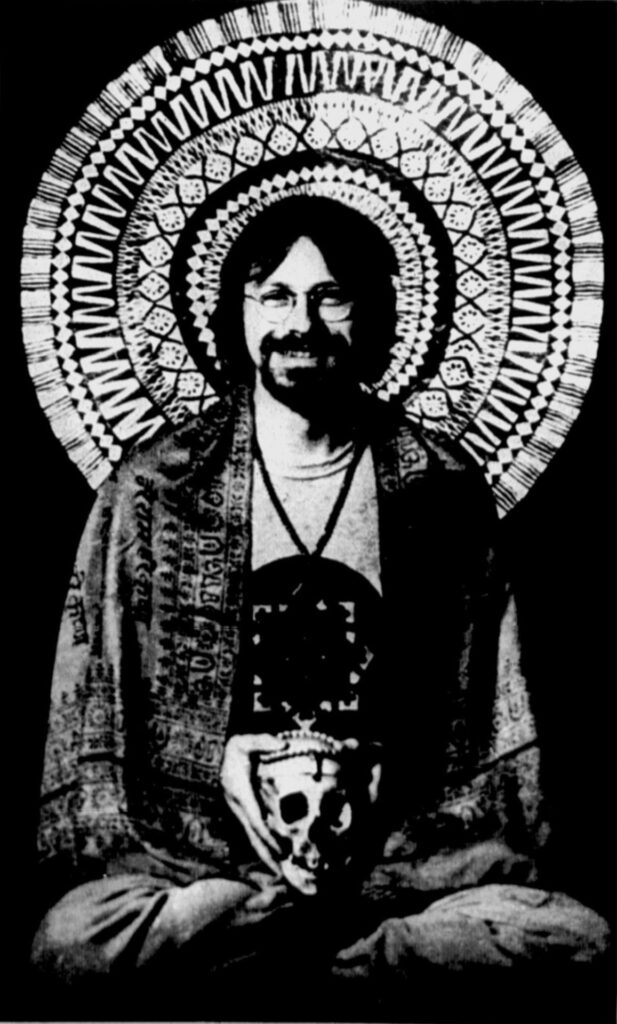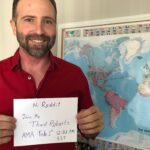
Boulder, Colo. – June 3, 1977
It wasn’t just any suicide. It was something out of the ordinary, almost theatrical.
On April 1, Edward Nylander, just 28 years old, sent a photo to ten of his friends. Nothing unusual at first glance, right? But this wasn’t your everyday snapshot. In the photo, Nylander was seated in a yoga pose, a skull resting eerily in his lap.
Fast forward ten days, and the scene became hauntingly real. Nylander’s burned body was discovered in a cave. He was seated just as he had posed in the photograph, a can of gasoline nearby. It was a chilling re-creation, as though the image he sent was a prelude to his own tragic finale.
Nylander wasn’t just any 28-year-old; to his friends, he was a self-declared guru with a flair for the mystical. In the days leading up to his tragic death, he left behind more than just a haunting photograph — he left instructions.
In carefully printed letters sent to his inner circle, Nylander waxed philosophical about the cycle of life and death. It wasn’t just a goodbye; it was a guide. He asked his friends to meditate on his photo, promising they’d be able to connect with him after he reincarnated. Start with three minutes, he wrote, then work up to twenty. It was a chilling request, as though he was choreographing his spiritual return from the beyond.
Nylander’s story was as complex as it was tragic. The son of a retired Air Force sergeant, he had a résumé that could impress anyone. He graduated from Oberlin College in Ohio, snagged an International Youth Award, taught yoga, and immersed himself in Eastern philosophies. He seemed like someone destined to leave a mark.
But Boulder wasn’t the easiest place for a self-styled guru to thrive. The city was already buzzing with spiritual seekers and leaders, all carving out their own followings. “There were already too many religious leaders,” one acquaintance remarked, hinting at the challenge Nylander faced in standing out. Despite his intellect and spiritual depth, finding his footing in this crowded landscape seemed like an uphill battle.
Nylander’s journey took a somber turn in the months leading up to his death. In 1974, he arrived in Boulder with his wife, seemingly ready to build a life rooted in both love and spirituality. But by late 1976, the marriage had crumbled, ending in divorce. Friends recalled how deeply the separation shook him.
Still, Nylander sought refuge where he always had — in his spiritual pursuits. He dove into meditation, studied mysticism with fervor, and even experimented with LSD, hoping to unlock the mysteries of altered states of consciousness. For him, these practices weren’t just hobbies — they were lifelines, a way to navigate the turbulence of his inner world.
By early 1977, Nylander’s life seemed to spiral further into the unknown. In February, he quit his job and left his apartment, stepping away from the stability most people cling to. By March, he had relocated to the Harvest House, a high-end hotel on the outskirts of Boulder.
From his new temporary haven, Nylander began preparing what would later feel like parting gifts. He carefully assembled ten packets for his closest friends. Each one was a mix of the profound and the personal — letters outlining his philosophies, haunting photographs, and keepsakes like his wedding pictures and even his high school diploma. It was as if he was curating a legacy, piecing together fragments of his life for those he’d soon leave behind.
On April 1, Nylander quietly checked out of the Harvest House. He paid his $500 bill in cash, a final gesture of closure. From there, he vanished into the foothills of Boulder, leaving behind only the eerie packets he had mailed to his friends.
Days later, his body was discovered in a cave, arranged in a way that was anything but random. Seated in a meditative yoga pose, his final moments seemed to echo the spiritual beliefs he had spent his life pursuing. It was a symbolic act, as if he had orchestrated his death to align perfectly with the mysticism he so deeply embraced.
Nylander’s death left his friends and family grappling with a mix of shock and sorrow. Those close to him were haunted by the clues he had left behind. “He left thousands of hints, but I never believed them until then,” a former co-worker admitted, reflecting on the cryptic trail Nylander had seemingly laid out.
Even his father, George Nylander, couldn’t shake an unsettling feeling after receiving his son’s letter. There was something ominous in the words, something that gnawed at him. Yet, like many, he held on to hope — hope that his fears were misplaced and his son’s musings were just part of his eccentric nature. Unfortunately, those hopes would soon be shattered.
Nylander’s death, shrouded in both tragedy and ritual, leaves behind a puzzle that refuses to be solved. Was this his ultimate expression of spiritual devotion, a deliberate step toward the next phase of existence? Or was it the act of a man consumed by emotional pain, searching for meaning in chaos?
The truth remains elusive, much like Nylander himself — a man whose life blended intellect, mysticism, and heartache in equal measure. His final act, as haunting as it was symbolic, leaves behind more questions than answers, ensuring his story lingers in the minds of those who knew him.





